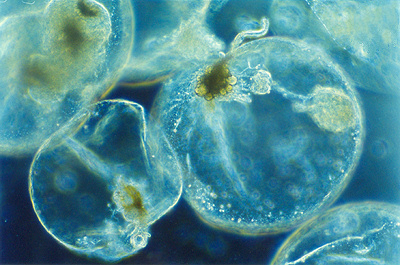Noctiluca scintillans, commonly known as the Sea Sparkle[1], and also published as Noctiluca miliaris, is a free-living non-parasitic marine-dwelling species of dinoflagellate that exhibits bioluminescence. The bioluminescent characteristic of N. scintillans is produced by a luciferin-luciferase system located in thousands of spherically shaped organelles, or “microsources”, located throughout the cytoplasm of this single-celled protist. Nonluminescent populations within the genus Noctiluca lack these microsources.
N. scintillans is a heterotrophic (non-photosynthetic) organism that engulfs its food (phagotrophic) which primarily consists ofplankton, including diatoms and other dinoflagellates, as well as fish eggs and bacteria. Diatoms are often found in the vacuoles(internal membrane-bound storage compartments) within these single-celled creatures. These green non-feeding symbioses can grow photoautotrophically for generations.[2] The diatom Thalassiosira sp. has been noted in the literature as a favored food source of these organisms.
N. scintillans can be found widely distributed throughout the world, often along the coast, in estuary, and shallow areas of the continental shelf that receive plenty of light which promotes the growth of the phytoplankton that make up a large portion of N. scintillans’s diet.
The size of the single-celled N. scintillans ranges from 200 to 2,000 µm in diameter, assuming the generally spherical shape. N. scintillans lacks the armor plates possessed by other types of dinoflagellates. And, unlike many other dinoflagellates, the chromosomes of the Noctiluca are not clearly visible and condensed throughout its lifecycle.
(From Wikipedia, May 31st, 2012)





